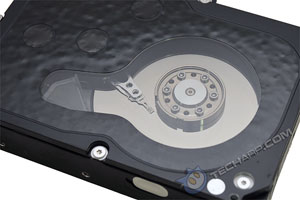The Clear Lens
 |
The Western Digital Raptor X is unique in the integration of a clear perspex lens on the top plate which allows a clear view of the drive mechanism. It's really cool to watch the platters spin and the read/write heads move during seeks.
According to Western Digital, the lens was specially designed not only to provide maximum view of the drive mechanism but also proper dissipation of static from the top plate.
You can also see that the Raptor X uses platters that are smaller than those used in "regular" 3.5" hard drives. As such, it has a relatively small storage capacity of 150 GB using just two platters. The smaller platter size also reduces its maximum transfer rate even as its higher spindle speed increases it. On the other hand, the smaller size and fewer number of platters allow the Raptor X to attain the high spindle speed of 10,000 RPM without excessive noise or heat levels.
The Connectors
 |
This is a Serial ATA hard drive, with native support for SATA 1.5 Gb/s, instead of the newer and faster SATA 3.0 Gb/s. However, you will have no problem using it with newer SATA 3.0 Gb/s controllers.
You do not need to be unduly worried about the "slower" interface though. The newer SATA 3.0 Gb/s interface may be "twice as fast" but that's only true for very short bursts of data from the SDRAM buffer. For sustained reads or writes, SATA 1.5 Gb/s is more than fast enough for all desktop hard drives. Even the Raptor X can only utilize about 56% of SATA 1.5 Gb/s' peak bandwidth.
Like all Serial ATA drives, it comes the standard SATA data (left) and power (right) connectors and is hot-pluggable. That means you can connect and disconnect this hard drive to your PC while it's still running.
To the left side of these SATA connectors is the jumper block. From what we can tell, Western Digital ships some drives with a jumper and others without a jumper. Since our OEM unit did not come with one, it is likely that only retail drives come with the jumper.
 |
Generally, you do not need to mess around with the jumper block. In this model, pins 1 and 2 enables Spread Spectrum Clocking (SSC).
Placing it across pins 3 and 4 will enable both spread spectrum clocking and the Power Management 2 (PM2) mode, also known as Power Up In Standby (PUIS) mode.
Finally, placing the jumper across pins 5 and 6 will force the drive to use the slower SATA 1.5Gbits/s (OPT1) interface. However, this setting is not applicable in this drive because it only supports the SATA 1.5 Gb/s interface.
The Breather Hole
The WD Raptor X has a single, tiny breather hole on the underside. You can see it in the picture below.
 |
The breather hole allows condensation inside the hard drive to escape. It also equalizes the hard drive's internal pressure with the ambient pressure. The hard drive needs it to function properly, so please make sure you do not occlude the hole!
<<< The Hard Drive, Usable Capacity, Specifications : Previous Page | Next Page : Testing The WD Raptor X, Platter Transfer Profile >>>







 Add to Reddit
Add to Reddit
